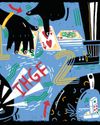
Planning a trip to the art museum usually doesn't require flippers and a wet suit. Yet the Underwater Museum of Art (UMA) in Florida has plunged into the art scene with an underwater sculpture exhibit. It's the first of its kind in the United States.
This unusual ocean exhibit is situated in the Florida Panhandle between Panama City and Destin on the Gulf of Mexico. It's about one mile (1.6 kilometers) offshore Grayton Beach State Park. Here, divers can swim 58 feet (18 meters) below the surface to view marine life interacting with sculptures. Over time, the works metamorphose into a living reef. This eco-tourist exhibit showcases artistic beauty. It also creates a safe haven for marine life and improves the overall health of the ecosystem.
Sculptures and Marine Life
The Underwater Museum of Art opened in 2018. Before that time, about 95 percent of this area was made up of barren sand flats. That's not exactly an ideal habitat for marine life. Today, thanks to the artificial reef made entirely of sculptures, the area is teeming with aquatic life. Tiny flashes of silver flicker as bait fish zip through the eyes of a pirate skull sculpture. One of the largest sculptures, this five-ton (4,536-kilogram) skull by artist Vince Tatum, is the exhibit centerpiece. UMA has a total of 41 sculptures, with more being added regularly.
Denne historien er fra July/August 2023-utgaven av Muse Science Magazine for Kids.
Start din 7-dagers gratis prøveperiode på Magzter GOLD for å få tilgang til tusenvis av utvalgte premiumhistorier og 9000+ magasiner og aviser.
Allerede abonnent ? Logg på
Denne historien er fra July/August 2023-utgaven av Muse Science Magazine for Kids.
Start din 7-dagers gratis prøveperiode på Magzter GOLD for å få tilgang til tusenvis av utvalgte premiumhistorier og 9000+ magasiner og aviser.
Allerede abonnent? Logg på

HOUSE OF CARDS
TRY THE PERFECT EXPERIMENT—AND THEN REFLECT ON HOW IT WENT.

ACCIDENTALLY Delicious
Have you ever been really hungry, but there wasn't much to eat in your kitchen? Did you throw together a bunch of stuff you had on hand and were pleasantly surprised when it tasted good?

IS YOUR SOCIAL MEDIA FEED TOO PERFECT?
EVERYONE'S LIFE CAN APPEAR PERFECT ON SOCIAL MEDIA. On YouTube, Instagram, Snapchat, and similar apps, people tend to share their happiest, most picturesque moments. They carefully compose any text to get the message just right. They use filters and enhancements to glam up images and videos. The app sorts the posts with the most likes and comments to the top. The end result? All you see of others' lives is the best of the best.

Art ALERT!
THE CASE OF THE MASTERPIECE THAT WASN'T

MARYAM ZARINGHALAM
SCIENCE POLICY FELLOW AND WRITER

Lost Cat Treks More Than 800 Miles to Get Home
Rayne Beau (pronounced RANE-BO, as in \"rainbow\") is a two-year-old Siamese cat.

EASY AS ABC
But in number theory, well, it's complicated.

That Wanaka Tree Gets a Companion
\"THAT WANAKA TREE,\" AS IT'S CALLED, IS A FAMOUS WILLOW TREE THAT GROWS OUT OF LAKE WANAKA ON THE SOUTH ISLAND OF NEW ZEALAND.

Two College Students Devise Smart Glasses That Can ID People
YOU'RE WAITING FOR THE SUBWAY WITH A COUPLE OF YOUR FRIENDS.

Two Comb Jellies Can Fuse Their Bodies Together to Become One
COMB JELLIES ARE GELATIN-LIKE AND MOSTLY SEETHROUGH INVERTEBRATES, OR ANIMALS WITHOUT A BACKBONE, THAT FLOAT IN THE OCEAN NEAR SHORE.